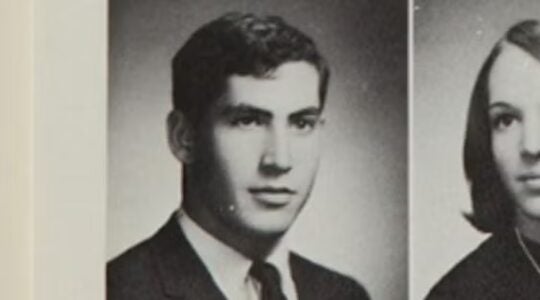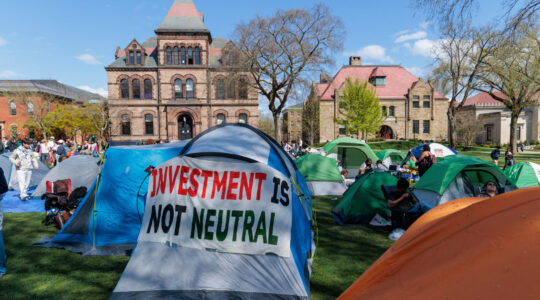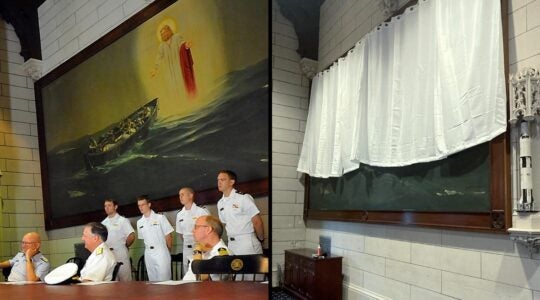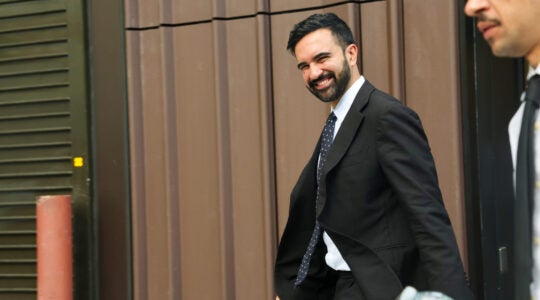SAN FRANCISCO, Dec. 7 (JTA) — Three dozen people, all women except for two young boys, are sitting around card tables in the Bureau of Jewish Education’s library getting ready to learn how to play mah jongg. Each table has a full set of 152 plastic tiles spread out, face down, and the players are listening to teacher Marc Wernick explain the rules.
“East throws out first,” he instructs each foursome. “Pick your lousiest tile, make a complaint about your kids, and throw it down.”
The women laugh knowingly. Talking about the family is a time-honored tradition in mah jongg, an ancient Chinese game that came over from Shanghai in the early 1920s.
In 1937 the National Mah Jongg League formed to standardize the rules for American play. There are more than 275,000 members today, most of them Jewish women. You join by paying $6.50 for a card mailed out every January that specifies that year’s winning hands, complicated combinations of tiles that change from year to year.
“When those cards come, no one speaks to each other for weeks,” Wernick says. “They’re all memorizing.”
Mah jongg caught on quickly in this country among Jewish women, but suffered a slump by the 1970s, when women entered the work force en masse and few young Jewish women took up the game. Mah jongg skipped a generation, although it lingered on in Miami high-rise buildings, Hadassah groups and senior centers.
Now there’s been a major resurgence of interest among women in their 20s, 30s and 40s. And what is being called the first online tournament will be held during Chanukah on Mahjongtime.com. The tournament starts at sundown Dec. 16 and runs through sundown Dec. 23, with the four players at the final table winning cash prizes up to $2,000.
In the game’s heyday, women would meet, usually weekly, at one another’s homes to play the fast-moving game, clicking and clacking their tiles, snacking on refreshments, and talking about their lives.
Judy Watman remembers her mother playing the game with her friends in their Cleveland home in the 1950s.
“The woman all had their little outfits on,” Watman recalls. “She had candy dishes all over, and everybody came dressed to the nines.”
Watman, who still has her mother’s card table and monogrammed mah jongg tablecloth, organized a beginners’ group two years ago at her synagogue, Beth Am Israel, along Philadelphia’s Main Line. Eight or nine women come each time, all members of the congregation.
“We talk about the holidays or things that happen in synagogue,” Watman says. “When someone’s sick, we support each other. It’s a female connection thing.”
Carole Soskis, who plays in the group, recalls lying in bed as a child in Portland, Maine, listening to her mother’s games.
“I’d hear the words — crak, bam, east. They sounded like magical things to me.”
Many of the younger women who are part of the resurgence say they are moved by nostalgia, looking to forge a connection with mothers and grandmothers who played the game before them.
The group at San Francisco’s Bureau of Jewish Education includes several mother-daughter pairs, one mother-son duo, and a multigenerational grouping.
Rochelle Green, 38, has come with her 66-year-old mother, Myra, and her 12-year-old daughter, Ariana Miller.
Green says her mom dragged them there.
“She said she wanted to expose us to Jewish games,” Green recalled. “I said, what, besides guilt?”
Both Green and Ariana liked the lesson, although they found it confusing.
“It was fun,” Ariana says shyly.
“Eventually we’ll buy a set and we can play together,” Myra Green declares.
Lynn Dunlop, 57, inherited her mother’s and grandmother’s sets, antiques made of ivory and bamboo. Although she learned how to play as a child, like many of her generation she says she stopped in her 30s, distracted by the demands of work and children.
Now she’s learning and wants to teach her daughters, “so I can leave them something besides dishes,” Dunlop says.
The mah jongg revival started about five years ago, but has gained momentum in the past year or two. Today many JCCs, synagogues, federations and other Jewish institutions are running beginners’ classes and holding drop-in sessions.
Melissa Singer, 41, plays with a young women’s Hadassah group near Phoenix. Her mother, both grandmothers and older sister have played for years. Melissa plays with her mother-in-law’s vintage ivory set; her sister plays with their grandmothers’ sets.
The sisters have taught their four young daughters, and this year at Thanksgiving they played a multigenerational game with the children’s grandparents.
Melissa’s daughter Ellie, 9, says she likes playing with her relatives.
“It made me feel I had a game I could play with my whole family,” Ellie says, admitting that her older sister “gets mad” when Ellie wins — which she often does, Singer says. “It’s hilarious, she wins on the same hand every time.”
Linda Feinstein has been teaching mah jongg for six years in and around Manhattan. She estimates that she’s taught more than 1,200 people, all women, virtually all Jewish. And the interest isn’t letting up.
“I’m totally full this month,” Feinstein says. “I keep thinking it’s going to stop, and it doesn’t.”
Feinstein saw a big upsurge after 9-11, as if people felt the need for comfort and camaraderie.
“People said, ‘I want to get together with other women, ‘ ” she says.
Most of her students are in their 50s or 60s. Many have brought their daughters.
“They want to do what their mothers did,” she says.
But it’s not just women anymore.
Jen Schiffman, 34, started learning with Feinstein in November. Schiffman’s grandmother plays, and she says she’s always wanted to learn. But the real impetus came when Schiffman and her husband, Scott, 37, were visiting his parents in Florida over Thanksgiving. The older couple are long-time players and offered to teach their daughter-in-law.
“My husband walked over and said, ‘teach me, too, ‘ ” Schiffman relates. “Hopefully one day we can find another couple to play with.”
Schiffman says she “didn’t realize” mah jongg had such a long Jewish history.
“For me, the nostalgia is because of my grandmother,” she says. “Now when she passes on, it won’t be lost.”
Roni Antebi organizes the Friday afternoon drop-in game at Seattle’s Jewish Community Center. The 12 to 15 regulars are women, mostly in their 60s or older. Except for 26-year-old David Smith.
Smith, a student at Bastyr University, decided to take up mah jongg as part of an assignment for a class on multicultural psychology. With one Jewish grandfather, he didn’t grow up Jewish, but was intrigued by mah jongg and thought it might be a good way to “reconnect” with his heritage.
In November he walked into the JCC and saw he was the only person in his 20s, and the only man.
“It was kind of awkward,” Smith admits. “They all thought I was in the wrong room.”
But the women quickly warmed to him and taught him the ropes. They didn’t even make him pay up when he lost, which he did every game.
“The ladies were so patient with me. They move so flippin’ fast!” Smith marvels.
On his second visit he showed up with cookies, and even won a game.
The women haven’t tried to fix him up yet, he reports, “but they have started to poke around.”
It’s all part of the game.
JTA has documented Jewish history in real-time for over a century. Keep our journalism strong by joining us in supporting independent, award-winning reporting.





